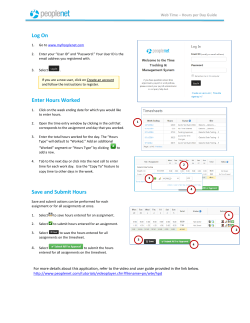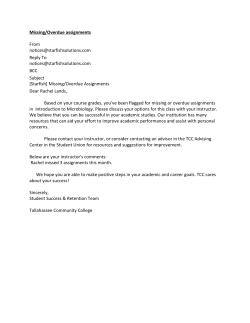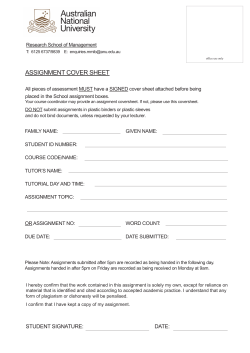
Course Information Sheet - EECS Instructional Support Group Home
Course Overview! CS 184/284a: Foundations of Computer Graphics! page 1 of 5! Spring 2015! Prof. James O’Brien This course is an introduction to the foundations of 3-dimensional computer graphics. Topics covered include 2D and 3D transformations, interactive 3D graphics programming with OpenGL, shading and lighting models, geometric modeling using Bézier and B-Spline curves, computer graphics rendering including ray tracing and global illumination, signal processing for antialiasing and texture mapping, and animation and inverse kinematics. There will be an emphasis on both the mathematical and geometric aspects of graphics, as well as the ability to write complete 3D graphics programs. This course is offered every semester (the instructor may vary from offering to offering, as may the content somewhat). ! This course will hopefully be a fun one, but it will require considerable implementation and understanding. The required programming for some of the assignments will be challenging for most students. Debugging and working with graphical programs requires substantial work. The main advice is to START EARLY on all of the programming assignments and ask the instructor or GSIs if you run into any difficulties; we are always ready to help. If an assignment provides 2 or 3 weeks to do it, it usually means you need all 2 or 3 weeks, and cannot start a few days before the deadline. Most students should successfully complete the assignments, and find the course very rewarding and fun, with the ability to understand the theory behind and implement 3D graphics programs. Some students every year are able to use the course as a springboard to pursue graduate study in computer graphics, or to take up positions in the graphics industry." This is the introductory graphics course. More advanced follow on courses are available. In particular, we strongly recommend those who do well in and/or enjoy this class to take CS 284b the next semester (do not worry about the fact that CS 284b is technically a graduate course; this course is ample preparation, and the grading is in fact usually easier in graduate classes). We also offer special topics CS 294 courses almost every semester. " ! " CS-184 Instructional Staff! Office E-Mail Address Prof. James O’Brien 527 Soda Hall job@berkeley.edu GSI Soham Uday Mehta TBA sohamum@eecs.berkeley.edu GSI Stephen Bailey TBA stephen.w.bailey@berkeley.edu Exam Schedule! Midterm Exam Wednesday, March 4, 3:30-5:00 pm, Location TBD Final Exam Wednesday, May 13, 7:00-10:00 pm, Location TBD Course Overview! CS 184/284a: Foundations of Computer Graphics! page 2 of 5! Spring 2015! Prof. James O’Brien Grading! Your grade will be determined by your performance on a combination of homework assignments, programming projects, one midterm, and one final exam. The percentages assigned to each of these categories are:" • Assignments" 40 %" • Midterm exam" 30 %" • Final exam" 30 %" ! ! Within each category, grading will be done using a point system. Each assignment, test question, and so on, will be worth some number of points. Your score in that category will simply be the number of points earned divided by the total possible. " Grading will be done on a curve. As a result if you, for example, score 10 points out of 70 on a homework, you should only be concerned if other people tended to score better than that. By the same token scoring 65 out of 70 should concern you if the rest of the class averaged 68. I try to gauge difficulty so that a very good performance is about 90%, but sometimes I under- or overestimate the difficulty of an exam or assignment. I also will adjust the curve upward or downward to account for the general performance of the class. " There will often be extra credit options on the assignments and tests. Points awarded for those get added in after the curve has been set... so they really are extra. " Prerequisites! A data structures course (e.g. CS 61B), C/C++ programming ability, and knowledge of linear algebra, calculus, and trigonometry. The first two assignments should be easy. If you find them baffling, you may have a problem and should consult the instructor." Assignments! You will have a couple of written assignments which will exercise your knowledge of the theoretical basis of computer graphics. They will also be good preparation for the exams. You may discuss problems with other students but all work for written assignments must be strictly your own. Please note that we were not able to hire psychic readers this semester: if your written assignments (or exam answers!) cannot be read they will not receive points. Written assignments should be turned in under Professor O'Brien's door. (527 Soda Hall, inside the Visual Computing Lab) " It is your responsibility to arrange time to turn in written assignments before the deadline. Soda Hall is locked in the evenings, nevertheless most undergrads manage to figure out ways into the building using elite ninja skills. If you lack these abilities please make sure you come to turn in your assignment before the building locks up. Failing to turn your assignment in because you were locked out of the building will incur standard lateness penalties." Course Overview! CS 184/284a: Foundations of Computer Graphics! page 3 of 5! Spring 2015! Prof. James O’Brien Programming assignments must compile and run on the instructional machines. It is your responsibility to make sure that they do. The first time you have a compile/run problem the grader has the option of allowing you to correct the problem. After the first time, the assignment may not be graded. " Test your programs on the instructional machines. In the past people have turned in programs that worked on their own machine and only verified that it compiled on the instructional machines. Variations in compiler and library versions then caused bugs that were benign on their home machine to manifest as runtime errors on the instructional machines. They lost points." Programing assignments other than Assignments #0 and #1 may be done in pairs or alone. If you work in a pair you only need to hand in one copy of any documentation required, but make sure that you indicate clearly who was included in the pair and how the task was divided up. If you work in a pair make sure that you think carefully about how you are going to divide up the programming effort between you so that you can coordinate your efforts without too much conflict." When you work in a group for the programing assignments, it is your responsibility to pick a good partner. Everyone in a group gets the same score. Please don't waste time by telling me that your partner was a slacker and that there should be some adjustment made to your scores. " Instructions for turning in each assignment will be included with each of the assignments and may vary over the semester. Read them carefully. Those instructions override anything contained in this document.! Most assignments will be due 11:59pm on a Friday. If it’s turned in before 11:59pm on Sunday that will count as one “day” late and be penalized 5%. Each additional 24 hour period will double the penalty. Example: Turned in by Friday is full points, Saturday or Sunday -5%, Monday -10%, Tuesday -20%, Wednesday -40%, Thursday -80%, after that the assignment can no longer be submitted for points. If you have some special circumstance that would prevent you from turning an assignment in on time, you must discuss the issue with me at least one week before the deadline. " Unless you are specifically told to do so, do not email your assignments to the instructor, TAs, or grader! It’s really, really annoying. Assignments submitted by email will be deleted unread and ungraded, and we will think poorly of you.! Expectations! This course has a reputation for somewhat demanding project work. You will have to write a lot of code and the algorithms you’ll need to implement are complex. You have been warned, no whining allowed.! Academic Honesty! I am generally happy for people to use code or ideas that they did not create themselves, but you must clearly declare what you have used from others and what was original from you. If you don't tell us anything, then we'll assume that you are presenting work as your own work. Presenting other peoples' work as your own is academic dishonesty. Collective responsibility applies: if you work in a pair, both of you will be held responsible for the resulting project. ! Course Overview! CS 184/284a: Foundations of Computer Graphics! page 4 of 5! Spring 2015! Prof. James O’Brien Students who engage in dishonest activities with intent to alter their grade will receive an 'F' in the course and then be reported to the University. Do not bother asking me to give you a second chance as it is a waste of time.! Under no circumstances should you submit materials obtained from a prior student in the class.! Communication! You are responsible for reading the discussion group on Piazza. The URL to access this group is https://piazza.com/berkeley/spring2014/cs184/home. All bug announcements and fixes for assignments and lectures will be distributed there. Please post using your real name." Routine communication about the course should be sent to cs184@imail.eecs.berkeley.edu or posted to the discussion group. If the issue is not private/personal then it is preferred you post to the discussion group. E-mail sent to the TA's or professor may be reposted on to the newsgroup in redacted form." If you have some issue that will prevent you from meeting an assignment deadline, or from sitting for an exam, you must let the professor know about it beforehand. I am happy to accommodate religious, medical, or family obligations (within reason). If some real emergency arises at the last minute that precludes prior communication, then be prepared to provide supporting documentation." Class Website! The class website is hosted at http://www-inst.cs.berkeley.edu/~cs184 . Copies of the lecture slides will be posted there a day or two before each class (or at least that’s my goal). You can also find supplemental materials there that may be useful." Dire Warning! Teaching a class to people who sit quietly is boring for the instructor. People who participate tend to learn more. So I would like to encourage class participation. If people appear to be interested and willing to participate then great... if not then I reserve the right to start giving really annoying little quizzes every class. " " Text Books! Required:" • " " P. Shirley, S. Marschner, et. al. Fundamentals of Computer Graphics (Make sure you get one of the newer editions as it has changed quite a bit from the early versions.)" Course Overview! CS 184/284a: Foundations of Computer Graphics! page 5 of 5! Spring 2015! Prof. James O’Brien Other Useful Textbooks:" " • J. Foley, A. van Dam, S. Feiner, J. Hughes.Computer Graphics: Principles and Practice" • A. Watt. 3D Computer Graphics" • D. Hearn, M. Baker. Computer Graphics with OpenGL" See the class webpage (and Google) for other useful resources.
© Copyright 2025









